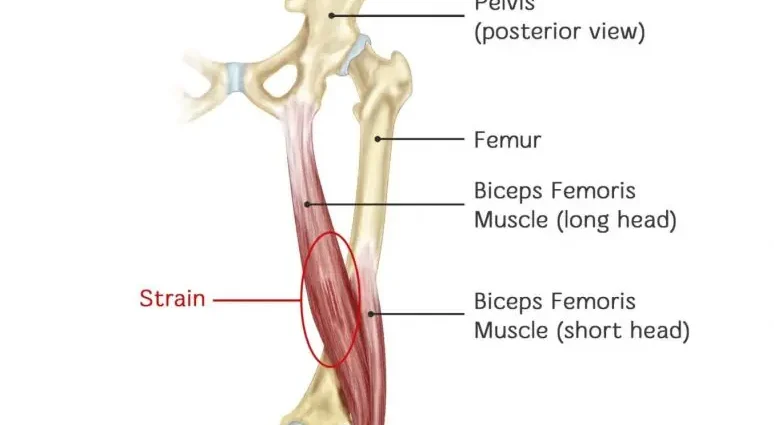Contents
Femoral biceps
The femoral biceps is part of the hamstring muscles located in the thigh.
Anatomy
Position. The femoral biceps is one of the hamstring muscles (semi-tendinous, semi-membranous, and femoral biceps) located in the posterior compartment of the thigh. The latter consists of a single bone, the femur, and three muscle compartments: the anterior compartment, the internal compartment, and the posterior compartment (1).
Structure. The biceps femoris muscle is a skeletal muscle, that is to say a muscle placed under the voluntary control of the central nervous system. It is made up of two heads: a long head and a short head.
Origin. The long head of the femoral biceps is inserted at the level of the ischial tuberosity, region of the ischial bone, itself belonging to the hip bone. The short head of the femoral biceps is inserted on the posterior part of the body of the femur at the level of the rough line and the lateral line (2).
Termination. The two heads of the femoral biceps meet to insert themselves on the lateral aspect of the head of the fibula, also called the fibula (3).
Innervation. The femoral biceps are innervated by the sciatic nerve (1).
Lower limb movements
Dynamics of the lower limb. The biceps femoris plays an essential role in various movements of the lower limb (3).
- Thigh extension. The femoral biceps allow the thigh to be extended, in particular to initiate walking.
- Leg flexion. When the knee is flexed, the biceps femoris allows the leg to flex.
- Lateral rotation of the leg. When the knee is flexed, the biceps femoris allows lateral rotation of the leg.
Femoral biceps and thigh pain
Some thigh pain can have a muscular origin and can be related to the biceps femoris.
Muscle pain without lesions. (4)
- Cramp. Sometimes occurring in the biceps femoris muscle, it corresponds to an involuntary, painful and temporary contraction of a muscle.
- Contracture. It is an involuntary, painful, and permanent contraction of a muscle such as the biceps femoris muscle.
Muscle injury. The biceps femoris muscle can suffer muscle damage, accompanied by pain. (4)
- Elongation. First stage of muscle damage, elongation corresponds to a stretching of the muscle caused by microtears and resulting in muscle disorganization.
- Breakdown. Second stage of muscle damage, the breakdown corresponds to a rupture of muscle fibers.
- Rupture. The last stage of muscle damage, it corresponds to a total rupture of a muscle.
Tendinopathies. They designate all the pathologies that can occur in tendons such as those associated with the biceps femoris. (5) The causes of these pathologies can be varied. The origin can be intrinsic as well with genetic predispositions, as extrinsic, with for example bad positions during the practice of sport.
- Tendinitis: It is an inflammation of the tendons.
Nervous pathologies. The thighs can also be the site of nervous pathologies such as, for example, sciatic neuralgia. Due to damage to the sciatic nerve, the latter is manifested by intense pain felt along the thigh and in particular in the biceps femoris.
Treatments
Drug treatments. Depending on the pathology diagnosed, different treatments may be prescribed to reduce pain and inflammation.
Surgical treatment. Depending on the type of condition diagnosed, surgery may be necessary.
Physical treatment. Physical therapies, through specific exercise programs, can be prescribed such as physiotherapy or physiotherapy.
Examination of the femoral biceps
Physical examination. First, a clinical examination is performed in order to observe and assess the symptoms perceived by the patient.
Medical imaging examination. X-ray, CT, or MRI exams can be used to confirm or further the diagnosis.
Anecdote
Lesions of the “hurdler”. The “hurdler” designates a hurdler. During this discipline, the femoral biceps and the semi-tendinous muscle may be torn off at the level of the ischial tuberosity. This lesion can in particular be linked to a forced flexion of the hip (3).










